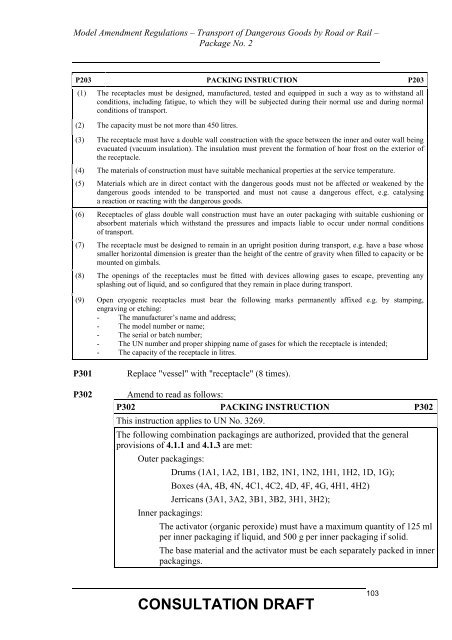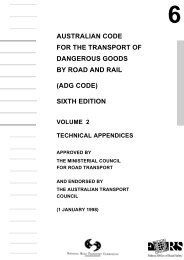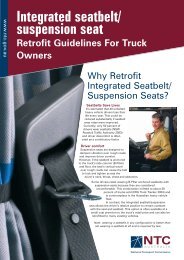Consultation Draft - National Transport Commission
Consultation Draft - National Transport Commission
Consultation Draft - National Transport Commission
Create successful ePaper yourself
Turn your PDF publications into a flip-book with our unique Google optimized e-Paper software.
Model Amendment Regulations – <strong>Transport</strong> of Dangerous Goods by Road or Rail –<br />
Package No. 2<br />
P203 PACKING INSTRUCTION P203<br />
(1) The receptacles must be designed, manufactured, tested and equipped in such a way as to withstand all<br />
conditions, including fatigue, to which they will be subjected during their normal use and during normal<br />
conditions of transport.<br />
(2) The capacity must be not more than 450 litres.<br />
(3) The receptacle must have a double wall construction with the space between the inner and outer wall being<br />
evacuated (vacuum insulation). The insulation must prevent the formation of hoar frost on the exterior of<br />
the receptacle.<br />
(4) The materials of construction must have suitable mechanical properties at the service temperature.<br />
(5) Materials which are in direct contact with the dangerous goods must not be affected or weakened by the<br />
dangerous goods intended to be transported and must not cause a dangerous effect, e.g. catalysing<br />
a reaction or reacting with the dangerous goods.<br />
(6) Receptacles of glass double wall construction must have an outer packaging with suitable cushioning or<br />
absorbent materials which withstand the pressures and impacts liable to occur under normal conditions<br />
of transport.<br />
(7) The receptacle must be designed to remain in an upright position during transport, e.g. have a base whose<br />
smaller horizontal dimension is greater than the height of the centre of gravity when filled to capacity or be<br />
mounted on gimbals.<br />
(8) The openings of the receptacles must be fitted with devices allowing gases to escape, preventing any<br />
splashing out of liquid, and so configured that they remain in place during transport.<br />
(9) Open cryogenic receptacles must bear the following marks permanently affixed e.g. by stamping,<br />
engraving or etching:<br />
- The manufacturer’s name and address;<br />
- The model number or name;<br />
- The serial or batch number;<br />
- The UN number and proper shipping name of gases for which the receptacle is intended;<br />
- The capacity of the receptacle in litres.<br />
P301<br />
P302<br />
Replace "vessel" with "receptacle" (8 times).<br />
Amend to read as follows:<br />
P302 PACKING INSTRUCTION P302<br />
This instruction applies to UN No. 3269.<br />
The following combination packagings are authorized, provided that the general<br />
provisions of 4.1.1 and 4.1.3 are met:<br />
Outer packagings:<br />
Inner packagings:<br />
Drums (1A1, 1A2, 1B1, 1B2, 1N1, 1N2, 1H1, 1H2, 1D, 1G);<br />
Boxes (4A, 4B, 4N, 4C1, 4C2, 4D, 4F, 4G, 4H1, 4H2)<br />
Jerricans (3A1, 3A2, 3B1, 3B2, 3H1, 3H2);<br />
The activator (organic peroxide) must have a maximum quantity of 125 ml<br />
per inner packaging if liquid, and 500 g per inner packaging if solid.<br />
The base material and the activator must be each separately packed in inner<br />
packagings.<br />
CONSULTATION DRAFT<br />
103






